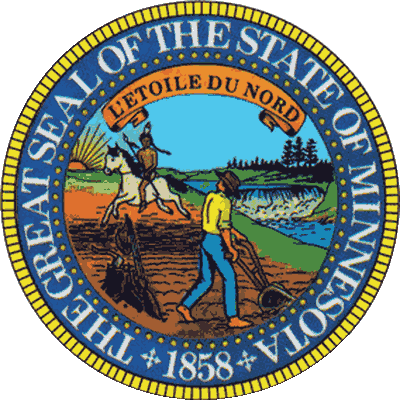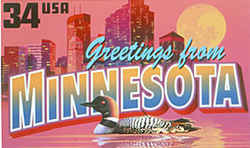- » 50 States
- » Histories
- » State Symbols
- » Seals
Minnesota State Seal
Great Seal of the State of Minnesota

Adopted in 1861.
The Great Seal of the State of Minnesota was adopted in 1861, with the present design legislated in 1983. Until 1974, the Minnesota Constitution required that the seal "shall be attached to all official acts of the governor requiring authentication."
The seal depicts a barefoot farmer plowing his field near St. Anthony Falls on the Mississippi River. His axe is driven into a tree trunk, with his rifle and powderhorn nearby. An Indian on horseback rides south, a summer setting sun in the background. The state motto, "L'Etoile du Nord", or "Star of the North", appears on a banner above the scenery. Around these images is the outermost ring, which reads "The Great Seal of the State of Minnesota". The bottom of the outer ring contains the date 1858, which is when Minnesota gained statehood.
Minnesota Great Seal
In 1849, Henry Sibley proposed that a picture created by Seth Eastman be adopted as the official Minnesota territorial seal. This proposal was adopted by the legislature. When Minnesota became a state in 1858, officials continued to use the territorial seal until 1861 when Minnesota Laws 1861, Chapter 43 was passed, creating an official state seal. The 1861 seal showed a settler plowing a field beside the Mississippi River near St. Anthony Falls. In the background, an Indian on horseback rides toward the setting sun. A banner shows the state motto "L'Etoile du Nord". In 1983 the seal was redesigned. (Laws of Minnesota 1983, Chapter 119) Norway pines (the state tree) were added behind St. Anthony Falls and the direction of the Indian was changed. He now rides toward the farmer rather than away from him.
[Note on private use of the state seal, from an attorney general's interpretation of Minnesota Statutes: "Private individuals can reproduce the state seal for their own purposes... the private enlargement, reduction, or embossment of the seal by private citizens is not prohibited. There are a number of consumer protection statutes that could conceivably prohibit the use of the state seal if it is used to misrepresent the nature of a business, or if a person in the course of his business, vocation, or occupation engages in any conduct that creates a likelihood of confusion or of misunderstanding...]"
Symbolism
The sun, visible on the western horizon, signifies summer in the northern hemisphere. The horizon's visibility signifies the flat plains covering much of Minnesota. The Indian on horseback is riding due south and represents the great Indian heritage of Minnesota. The Indian's horse and spear and the Pioneer's ax, rifle, and plow represent tools that were used for hunting and labor. The stump symbolizes the importance of the lumber industry in Minnesota's history. The Mississippi River and St. Anthony Falls are depicted to note the importance of these resources in transportation and industry. The cultivated ground and the plow symbolize the importance of agriculture in Minnesota. Beyond the falls three pine trees represent the state tree and the three great pine regions of Minnesota; the St. Croix, Mississippi, and Lake Superior.
Minnesota Seal Law
MINNESOTA STATE SEAL: adopted 1861.
Statutory citation: Minn. Stat. 1.135
History:
1849 (territorial seal adopted)
1861 Minn. Laws Chap. 43 - "The seal heretofore used as the seal of this state, shall be the seal thereof."
1957 ??
1971 - Revised seal approved by secretary of state but not by the legislature.
1983 Minn. Laws Chap. 119 Sec. 1 (SF808) - Describes the seal.
Until 1974, the Minnesota Constitution required that the seal "shall be attached to all official acts of the governor requiring authentication."
1.135 State seal.
Subdivision 1. Purpose. This section prescribes the design and states the historical symbolism of the Great Seal of the State of Minnesota.
Subd. 2. Official seal. The seal described in subdivision 3 is the "Great Seal of the State of Minnesota." When the seal, the impression of
the seal, the scene within the seal, or its likeness is reproduced at state expense, it must conform to subdivision 3 and section 4.04. A seal, impression,
scene, or likeness which does not conform to these provisions is not official.
Subd. 3. Design. The design of the seal is as described in this subdivision.
(a) The seal is composed of two concentric borders. The outside forms the border of the seal and the inside forms the border for the illustrations
within the seal. The area between the two borders contains lettering.
(b) The seal is two inches in diameter. The outside border has a radius of one inch and resembles the serrated edge of a coin. The width of the border
is 1/16 of an inch.
(c) The inside border has a radius of three-fourths of an inch and is composed of a series of closely spaced dots measuring 1/32 of an inch in diameter.
(d) Within the area between the borders "The Great Seal of the State of Minnesota" is printed in capital letters. Under that is the date "1858" with
two dagger symbols separating the date and the letters. The lettering is 14-point century bold.
(e) In the area within the inside border is the portrayal of an 1858 Minnesota scene made up of various illustrations that serve to depict a settler
plowing the ground near the falls of St. Anthony while he watches an Indian on horseback riding in the distance.
(f) For the purposes of description, when the area within the inside border is divided into quadrants, the following illustrations should be clearly
visible in the area described.
(1) In the upper parts of quadrants one and two, the inscription "L'Etoile du Nord" is found on the likeness
of a scroll whose length is equal to twice the length of the inscription, but whose ends are twice folded underneath and serve to enhance the inscription.
The lettering is 7-point century bold.
(2) In quadrant two is found a likeness of a sun whose ambient rays form a background for a male Indian in loincloth and plume riding on horseback
at a gallop. The Indian is sitting erect and is holding a spear in his left hand at an upward 60-degree angle to himself and is looking toward the
settler in quadrant four.
(3) In quadrant one, three pine trees form a background for a picturesque resemblance of St. Anthony Falls in 1858.
(4) In quadrants three and four, cultivated ground is found across the lower half of the seal, which provides a background for the scenes in quadrants
three and four.
(5) In quadrant three, a tree stump is found with an ax embedded in the stump and a period muzzle loader resting on it. A powder flask is hanging towards
the end of the barrel.
(6) In quadrant four, a white barefoot male pioneer wearing clothing and a hat of that period is plowing the earth, using an animal-drawn implement
from that period. The animal is not visible. The torso of the man continues into quadrant two, and he has his legs spread apart to simulate movement.
He is looking at the Indian.
Subd. 4. Additional effects; size. Every effort shall be made to reproduce the seal with justification to the 12 o'clock position and with attention
to the authenticity of the illustrations used to create the scene within the seal. The description of the scene in this section does not preclude the
graphic inclusion of the effects of movement, sunlight, or falling water when the seal is reproduced. Nor does this section prohibit the enlargement,
proportioned reduction, or embossment of the seal for its use in unofficial acts.
Subd. 5. Historical symbolism of seal. The sun, visible on the western horizon, signifies summer in the northern hemisphere. The horizon's visibility
signifies the flat plains covering much of Minnesota. The Indian on horseback is riding due south and represents the great Indian heritage of Minnesota.
The Indian's horse and spear and the Pioneer's ax, rifle, and plow represent tools that were used for hunting and labor. The stump symbolizes the importance
of the lumber industry in Minnesota's history. The Mississippi River and St. Anthony Falls are depicted to note the importance of these resources in
transportation and industry. The cultivated ground and the plow symbolize the importance of agriculture in Minnesota. Beyond the falls three pine trees
represent the state tree and the three great pine regions of Minnesota; the St. Croix, Mississippi, and Lake Superior.
Subd. 6. State's duties. State agencies and departments using the seal, its impression, the scene within the seal or its likeness shall make
every effort to bring any seal, impression, scene, or likeness currently fixed to a permanent object into accordance with this section and section
4.04. Expendable material to which the seal or any impression, scene, or likeness is currently affixed may be used until the supply is exhausted. All
unused dies and engravings of the Great Seal shall be given to the Minnesota historical society, along with all historical information available about
the seal, to be retained in the society's permanent collection.
HIST: 1983 c 119 s 1; 1987 c 384 art 1 s 1
Copyright 2002 by the Office of Revisor of Statutes, State of Minnesota.








